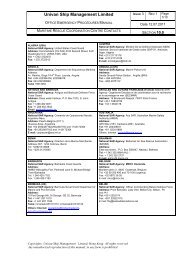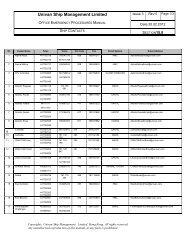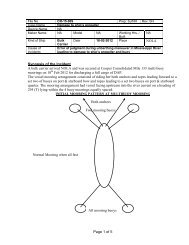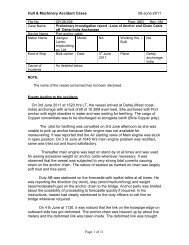Section: 11 CARGO OPERATIONS - Univan
Section: 11 CARGO OPERATIONS - Univan
Section: 11 CARGO OPERATIONS - Univan
You also want an ePaper? Increase the reach of your titles
YUMPU automatically turns print PDFs into web optimized ePapers that Google loves.
<strong>Univan</strong> Ship Management Limited Issue 1 REV 0 Page<br />
4/8<br />
FLEET OPERATION MANUAL Date 01.01.2005<br />
SECURING OF CONTAINERS<br />
Copyrights: <strong>Univan</strong> Ship Management Limited, Hong Kong. All rights reserved<br />
Any unauthorized reproduction of this manual, in any form is prohibited<br />
SECTION <strong>11</strong>.9<br />
sockets (for twistlocks). Sometimes, however, the chocking is not secure within itself, and<br />
shipped seas in particular have a habit of breaking up the chocking arrangement.<br />
Poor lashing angles and leads are yet another example of incorrect securing device application.<br />
This is not usually a problem on vessels designed or properly adapted for the carriage of<br />
containers on deck, since the deck/hatch lashing points are positioned to avoid chafing and to be<br />
most effective in terms of resisting forces. A common example of the chafing problem arising on<br />
non-purpose-built containerships is loop lashing. This is the bad practice of lashing two adjacent<br />
containers with one wire, which passes through the adjacent corner castings of each container.<br />
Such a practice may lead to the wire becoming overloaded. Overloading can also occur where<br />
fixed securing devices, like deck eye pads, are made to hold more lashings than they can safely<br />
take. Such an arrangement is often associated with poor lashing leads, and accordingly the<br />
problem becomes compounded.<br />
The looseness of lashings could be said to be another area of incorrect securing device<br />
application. This can lead to a container or containers gaining momentum as mentioned above.<br />
Slack securing usually arises from stevedore/crew laziness, poor workmanship and/or<br />
perceived/actual time constraints, and such shortfalls are exacerbated when, through poor<br />
maintenance, devices are too stiff to operate. Common examples of this are twistlocks left in the<br />
not fully closed position and slack turnbuckles. Of course, securing devices may also work<br />
themselves loose during a voyage, particularly in heavy weather.<br />
Picture: 1-Mixed Twist Locks<br />
Picture: 2 Uniform Twist locks









